FROM THE AVANT-GARDE TO THE DIGITAL AGE: HOW TECHNOLOGY CHANGED THE ART OF MUSIC IN THE TWENTIETH CENTURY
DOI:
https://doi.org/10.24193/subbmusica.2025.spiss2.02Keywords:
digital art, contemporary music, music of the 20th century, electronic musicAbstract
The twentieth century is characterized by the rapid development of technology, including in the field of sound recording and the production of electric musical instruments. The purpose of this study is to find out what changes technological innovations have led to in the art of music, and what areas of musical art they have led to. The paper presents tables of key inventions in the field of sound recording, development of electric musical instruments and software that were key to the development and emergence of new areas of musical art. The role of electric musical instruments is considered from the standpoint of enriching the timbral palette of musical art: electronic technologies open up the possibility of generating timbres that have no analogues among acoustic instruments and thus significantly enrich the field for creative research. The role of technology in the formation of rock music, electronic dance music, algorithmic music, and the emergence of folk electronics is clarified. The author shows the sociological aspect of musical creativity, which in the XX century is characterized by the acceleration of information exchange between musicians, the expansion of the amount of musical material available for listening to users due to the possibility of their fixation on material media, and at the end of the XX century – transmission via the Internet.
References
1. Bondarenko, A. Electronic Music in Ukraine at the Beginning of the XX Century. PhD dissertation, Kyiv National University of Culture and Arts, 2021.
2. Bondarenko, A. I. Modern Musical Art and Computer Programs: A Textbook. Lira-K Publishing, 2022.
3. Broiako, N. “E. Stankovych’s ‘Symnoi Drimbi Zvyki’ in the Aspect of Embodiment of the Neofolkloristic Tendencies.” Music Art and Culture, vol. 1, no. 30, 2020, pp. 19–24. https://doi.org/10.31723/2524-0447-2020-30-1-3.
4. Corbelli, A. “Beyond the Algorithm. Ethical and Aesthetic Challenges of AI in Music.” Itinera, no. 28, 2024, pp. 172–186. https://doi.org/10.54103/2039-9251/27842.
5. Eno, Brian. “The Studio as Compositional Tool.” Audio Culture: Readings in Modern Music, edited by Christoph Cox and Daniel Warner, Continuum, 2009, pp. 185–88. https://doi.org/10.5040/9781501318399.ch-022.
6. Holmes, Thom. Electronic and Experimental Music: Technology, Music and Culture. 3rd ed., Routledge, 2008.
7. Jayanthi, J., and V. Upendran. “Raga Recognition of Indian Classical Music Using Meerkat Optimization Based MFCC and Fine Tuned BILSTM-XGBOOST.” Circuits, Systems, and Signal Processing, 2025. https://doi.org/10.1007/s00034-025-02999-w.
8. Kravchuk, O. “Application of Artificial Intelligence in the Music Industry of Ukraine: An Analytical Approach.” Bulletin of Kyiv National University of Culture and Arts. Series in Musical Art, vol. 6, no. 1, 2023, pp. 79–88. https://doi.org/10.31866/2616-7581.6.1.2023.277888.
9. Kushch, Y. V. Electromusical Instruments as an Evolutionary Factor of Musical Culture in the 20th – Early 21st Century. PhD dissertation abstract, Kyiv, 2013.
10. Lazarev, S. H. Electronic Music as a Socio-Cultural Phenomenon (Second Half of the 20th Century – Early 21st Century). PhD dissertation, National University of Culture and Arts, 2018.
11. Lerch, Alexander. “The Relation Between Music Technology and Music Industry.” Springer Handbook of Systematic Musicology, edited by Rolf Bader, Springer, 2018, pp. 899–909. https://doi.org/10.1007/978-3-662-55004-5_44.
12. Macan, Edward. Rocking the Classics: English Progressive Rock and the Counterculture. Oxford University Press, 1997. https://doi.org/10.1093/acprof:oso/9780195098884.001.0001.
13. Manulyak, O. “Changes in the Structure of the Sound Material of Electroacoustic Works by Ukrainian Composers of the End of the 20th – Beginning of the 21st Century in the Context of Socio-Political Changes.” Scientific Collections of the Lviv National Music Academy Named after M. V. Lysenko, vol. 49, no. 2, 2023, pp. 22–27. https://doi.org/10.32782/2310-0583-2023-49-04.
14. Marynin, A. Ye. “Transformation of Digital Technologies in Music Industry in the Late XX – Early XXI Century.” Bulletin of National Academy of Managerial Staff of Culture and Arts, no. 2, 2024, pp. 311–15. https://doi.org/10.32461/2226-3209.2.2024.308417.
15. Millard, A. J. The Electric Guitar: An American Icon. Johns Hopkins University Press, 2004. https://doi.org/10.56021/9780801878626.
16. Moore, S., et al. “Ndwom: A Multimodal Music Information Retrieval Dataset for Akan Musical Videos.” 2025. https://doi.org/10.21203/rs.3.rs-5876078/v1.
17. Naidu, P., et al. “Classification of Music Genres Using Multimodal Deep Learning Technique.” E3S Web of Conferences, vol. 616, 2025, 02012. https://doi.org/10.1051/e3sconf/202561602012.
18. Nyakayo, O. A. “The Intersection of Science and Art: Collaborative Approaches.” Newport International Journal of Engineering and Physical Sciences, vol. 5, no. 1, 2025, pp. 1–6. https://doi.org/10.59298/NIJEP/2025/511600.
19. Ostberg, J., and B. Hartmann. “The Electric Guitar – Marketplace Icon.” Consumption Markets and Culture, vol. 18, no. 5, 2015, pp. 402–10. https://doi.org/10.1080/10253866.2015.1046255.
20. Piddubnyk, V. “Technological Progress in the Music Industry and Its Impact on the Professional Concept of Music Creation.” Art Education and Development of Creative Personality, no. 1, 2024, pp. 68–74. https://doi.org/10.32782/ART/2024-1-12.
21. Pobiedonostseva, I. Ye. Television Discourse in the Cultural Space of Postmodernism. PhD dissertation, Kyiv, 2005.
22. Poplavskyi, M. M., and Yu. V. Trach. “Digitalization of the Music Industry: Trends and Prospects.” Bulletin of National Academy of Managerial Staff of Culture and Arts, no. 2, 2022, pp. 30–39. https://doi.org/10.32461/2226-3209.2.2022.262202.
23. Sampada, K. S. Algorithmic Orchestration: Deep Learning Techniques in Music Generation. 2025. http://dx.doi.org/10.52783/pst.1623.
24. Siuta, B. Musical Creativity of the 1970s–1990s: Parameters of Artistic Integrity. Hramota, 2006.
25. Stockfelt, Ola. “Adequate Modes of Listening.” Keeping Score: Music, Disciplinarity, Culture, edited by David Schwarz et al., University Press of Virginia, 1997, pp. 88–93.
26. Stockhausen, Karlheinz. Texte 2: Aufsätze 1952–1962 zur Musikalischen Praxis. Edited by Dieter Schnebel, Verlag M. DuMont Schauberg, 1964.
27. Wu, R., and Y. Pan. “Providing Music Selection and Matching Suggestions for Dance Creations Using Music Information Retrieval and Artificial Intelligence Techniques.” Journal of Computational Methods in Sciences and Engineering, 2025. https://doi.org/10.1177/14727978251318807.
28. Yang, Y. “Analysis of Different Types of Digital Audio Workstations.” Highlights in Science, Engineering and Technology, vol. 85, 2024, pp. 563–69. https://doi.org/10.54097/6vvy8z41.
29. Yuferova, H. V. Musical Computer Technologies in Communication Processes in Contemporary Ukrainian Music. PhD dissertation, Kyiv, 2021.
Downloads
Published
How to Cite
Issue
Section
License
Copyright (c) 2025 Studia Universitatis Babes-Bolyai Musica

This work is licensed under a Creative Commons Attribution-NonCommercial-NoDerivatives 4.0 International License.



